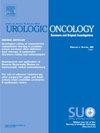TESTIS CANCER PRESENTATION, SURGICAL MANAGEMENT, AND MORTALITY ACROSS THE RURAL-URBAN CONTINUUM IN THE NATIONAL CANCER DATABASE (NCDB)
IF 2.4
3区 医学
Q3 ONCOLOGY
Urologic Oncology-seminars and Original Investigations
Pub Date : 2025-03-01
DOI:10.1016/j.urolonc.2024.12.085
引用次数: 0
Abstract
Introduction
Testicular neoplasms, though infrequent overall, are the most common tumors in men aged 20-40, with 95% classified as seminoma and non-seminomatous germ cell tumors. In the U.S., the incidence is approximately 1 per 250 males, showing a rise over recent decades, while mortality rates have decreased. For stage I or IIA nonseminomatous germ cell tumors, primary retroperitoneal lymph node dissection (RPLND) provides crucial therapeutic and diagnostic benefit due to the tumor's limited metastatic spread. Disparities persist in testicular cancer outcomes partly due to limited access to high volume specialty surgical care, and based on race and ethnicity with increased mortality noted for Hispanic men. This study aims to explore these disparities further by analyzing clinical outcomes, including presentation and surgical management, across rural and urban areas using the National Cancer Database (NCDB), to better understand how geographical factors influence testicular cancer outcomes.
Methods
Our retrospective study, utilizing the NCDB, explores disparities in testicular cancer outcomes among men diagnosed with seminoma (SGCT) and nonseminomatous germ cell tumors (NSGCT). Individuals were assigned to geographic areas using Rural-Urban continuum codes (RUCCs) for their county of residence at the time of diagnosis: large metropolitan (population ≥1 million), medium metropolitan (population 250,000-1 million), small metropolitan (population <250,000), urban (population 2,500->20,000), and rural (population <2,500). Univariate analysis examined sociodemographic, clinical, and treatment variables. Risk of mortality across the rural-urban continuum was assessed using multivariable Cox regression adjusted for age, pathologic stage, chemotherapy, radiation therapy, race, insurance, surgery type, and area of residence. Kaplan-Meier survival curves assessing mortality based on residence and distance from treating facility were also generated. We also assessed long-term survivorship by examining mortality from time of diagnosis.
Results
Our cohort of 100,805 had a geographic breakdown of large- (N=55,910), medium- (N=22,089), small-metropolitan (N=9,804), urban (N=11,692), and rural (N=1,310). Disparities were observed including age at diagnosis (p=0.016), race/ethnicity, insurance coverage, educational attainment, and income (all with p<0.001). Unadjusted Cox proportional hazards models reveal urban patients showed increased odds for RPLND overall (OR= 1.10 (1.04-1.17), p=0.002) and uninsured patients having the lowest odds overall for all stages (OR= 0.72 (0.65-0.80), p<0.001). In multivariable models, distance to treating facility was positively associated with RPLND (OR= 1.10 (1.07-1.13), p<0.001) and patients residing >50 miles from their treatment facility showing the highest odds of RPLND (OR= 4.34 (4.12-4.57), p<0.001). Residents of rural areas had the highest mortality risk within 5–10 years and >10 years following diagnosis (OR= 2.81 (2.06-3.85) and OR= 1.75 (1.47-2.07), p<0.001 (both), respectively).
Conclusions
This study emphasizes the role demographic, socioeconomic, and geographic considerations play in predicting mortality outcomes for patients with testis cancer. Our data suggests that based on patient geographic area of residence, rural patients and those with the greatest distance traveled have worse outcomes and may require continued surveillance past the 5-year timeline suggested by current guidelines. Our findings underscore the need for outreach and collaboration with local providers to refer suspicious testicular masses for earlier urologic evaluation and continued monitoring.
国家癌症数据库(ncdb)中农村-城市连续体睾丸癌的表现、手术治疗和死亡率
睾丸肿瘤虽然总体上并不常见,但却是20-40岁男性中最常见的肿瘤,其中95%分为精原细胞瘤和非精原细胞性生殖细胞肿瘤。在美国,发病率约为每250名男性中有1名,近几十年来呈上升趋势,而死亡率却有所下降。对于I期或IIA期非半细胞性生殖细胞肿瘤,原发性腹膜后淋巴结清扫术(RPLND)提供了至关重要的治疗和诊断益处,因为肿瘤的转移扩散有限。睾丸癌预后的差异仍然存在,部分原因是获得大量专科手术护理的机会有限,以及基于种族和民族的差异,西班牙裔男性的死亡率较高。本研究旨在通过使用国家癌症数据库(NCDB)分析农村和城市地区的临床结果,包括表现和手术管理,进一步探讨这些差异,以更好地了解地理因素如何影响睾丸癌结果。方法一项回顾性研究,利用NCDB,探讨诊断为精原细胞瘤(SGCT)和非精原细胞瘤生殖细胞瘤(NSGCT)男性睾丸癌预后的差异。使用城乡连续代码(RUCCs)将个体按其诊断时居住的县划分为地理区域:大都市(人口≥100万)、中等大都市(人口25万- 100万)、小大都市(人口25万)、城市(人口2500 - 2万)和农村(人口2500)。单变量分析检查了社会人口学、临床和治疗变量。采用多变量Cox回归评估城乡连续体的死亡风险,校正了年龄、病理分期、化疗、放疗、种族、保险、手术类型和居住地区。还生成了基于居住地和离治疗设施距离评估死亡率的Kaplan-Meier生存曲线。我们还通过检查诊断时的死亡率来评估长期生存率。结果100,805名研究对象的地理分布分为大城市(N=55,910)、中等城市(N=22,089)、小城市(N=9,804)、城市(N=11,692)和农村(N=1,310)。差异包括诊断年龄(p=0.016)、种族/民族、保险覆盖率、受教育程度和收入(p= 0.001)。未经调整的Cox比例风险模型显示,城市患者总体上RPLND的几率增加(OR= 1.10 (1.04-1.17), p=0.002),而未投保患者在所有阶段的总体几率最低(OR= 0.72 (0.65-0.80), p<0.001)。在多变量模型中,到治疗机构的距离与RPLND呈正相关(OR= 1.10 (1.07-1.13), p<0.001),居住在距离治疗机构50英里的患者RPLND的几率最高(OR= 4.34 (4.12-4.57), p<0.001)。农村居民在诊断后5 ~ 10年和10年内的死亡风险最高(OR= 2.81 (2.06 ~ 3.85), OR= 1.75 (1.47 ~ 2.07), p< = 0.001(均为)。结论:本研究强调了人口学、社会经济和地理因素在预测睾丸癌患者死亡率结果中的作用。我们的数据表明,根据患者居住的地理区域,农村患者和旅行距离最远的患者预后较差,可能需要在当前指南建议的5年时间内继续监测。我们的研究结果强调需要与当地提供者合作,将可疑的睾丸肿块进行早期泌尿系统评估和持续监测。
本文章由计算机程序翻译,如有差异,请以英文原文为准。
求助全文
约1分钟内获得全文
求助全文
来源期刊
CiteScore
4.80
自引率
3.70%
发文量
297
审稿时长
7.6 weeks
期刊介绍:
Urologic Oncology: Seminars and Original Investigations is the official journal of the Society of Urologic Oncology. The journal publishes practical, timely, and relevant clinical and basic science research articles which address any aspect of urologic oncology. Each issue comprises original research, news and topics, survey articles providing short commentaries on other important articles in the urologic oncology literature, and reviews including an in-depth Seminar examining a specific clinical dilemma. The journal periodically publishes supplement issues devoted to areas of current interest to the urologic oncology community. Articles published are of interest to researchers and the clinicians involved in the practice of urologic oncology including urologists, oncologists, and radiologists.

 求助内容:
求助内容: 应助结果提醒方式:
应助结果提醒方式:


